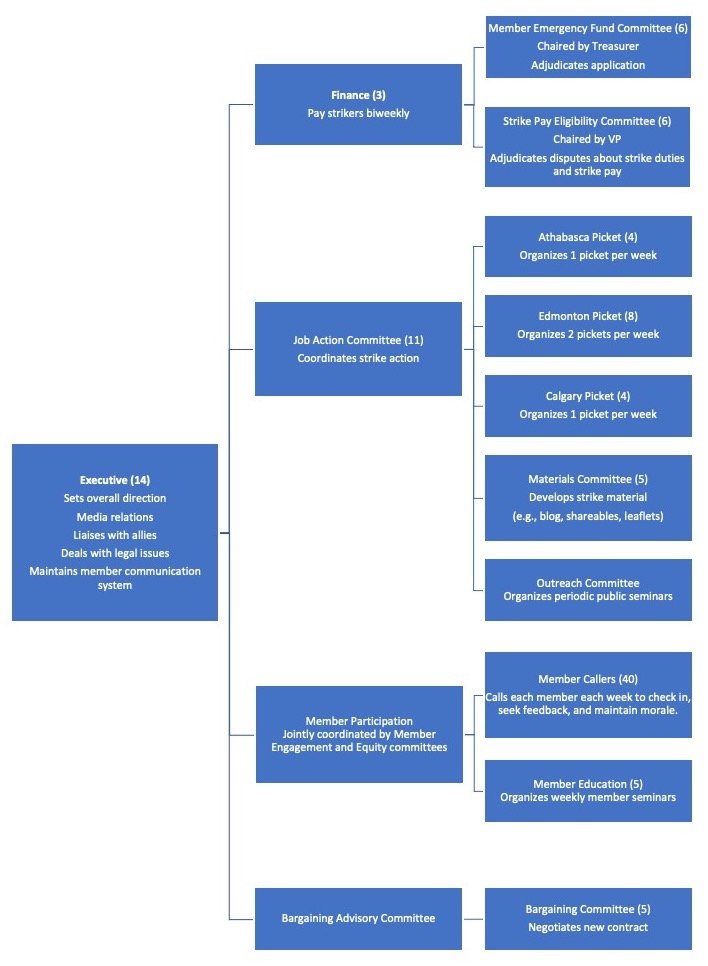Back in December, AUFA’s Job Action Committee (JAC) provided an overview of flying (i.e., in-person) and digital picketing. As a potential strike and/or lockout looms, this post provides additional details about digital picketing during the first few weeks of any work stoppage. An earlier post this week provided some additional details on flying pickets.
Overview of Digital Pickets
If a strike or lockout occurs, AUFA will be organizing four kinds of digital picketing to start with:
recruiting individuals to sign AUFA’s online petition,
sharing materials on social media,
contacting selected individuals (administrators, university donors, MLAs) by phone and email, and
contacting non-striking staff to check in on them and ask them to honour our picket line.
Each day AUFA members will receive updated instructions about digital picketing activities.
Some forms of digital picketing will entail the use of email or social media accounts. Members interested in creating anonymous email and social media accounts can follow these instructions.
Instructions for email: Disposable email account - How to.pdf
Instructions for social media: Disposable Twitter account - How to.pdf
Recruiting Individuals to Sign AUFA’s Online Petition
AUFA will be launching an online petition that emails each petition signature to key actors at AU. Petition signatories will be pledging not to enroll in an AU course and not to recommend AU to others until a fair deal is concluded. The purposes of the petition are to:
easily allow allies and the public to support us, and
apply reputational and financial pressure to settle by demonstrating large numbers of interested students are refraining from registering in AU courses until the strike ends.
Individual AUFA members will be asked to use their networks of family, friends, colleagues, and acquaintances to solicit five (or more!) signatures per day. This work will supplement our in-person leafletting work with current PSE students on campuses that send AU significant numbers of visiting students.
What to do:
Each day, contact five people you know individually by phone, video chat, email, text, or by seeing them in person. If you are nervous about this, start close to home with family and friends.
Explain you are on strike, and that you need two minutes of their time to help us get a fair deal.
Ask them to sign the online petition (link and QR code provided).
What not to do:
Do not mass email your contact list; that approach is ineffective. Personalized communications matter.
Sharing Materials on Social Media
AUFA will be providing a daily shareable (e.g., photos, memes, infographics) for members to share on social media. The purposes of these shareables are to:
generate public awareness of the strike by flooding social media spaces,
apply reputational pressure on the employer to settle, and
drive traffic to our online petition.
What to do:
Share the memes on your social media accounts (e.g., Facebook, twitter, Instagram, Reddit, TikTok, and so on).
Where a social media platform uses tags, ensure you use: #AUFAStrike #AthabascaU
Express how the employer’s behaviour is affecting you, such as “I’m tired to being treated poorly”, “I miss my students”, or “I’d rather be working”.
If you would like to add your own comments to a post, consider making a clear demand, such as “negotiate a fair deal” or “fair wages now”.
Direct interested people to our online petition.
What not to do:
Do not engage with online trolls; they are not making good-faith arguments, are a waste of time, and are best ignored and/or blocked.
Contacting Selected Individuals by Phone or Email
AUFA will be providing a rotating list of the names, emails, and/or phone numbers of selected individuals for members to contact. These individuals are people who may be able to help us get a fair deal. This list will include members of Athabasca University’s Board of Governors and Executive Group, as well as donors, and MLAs. The purposes of these contacts are to:
generate awareness of the strike among key audiences, and
apply pressure (social, reputational, and financial) on the Board to settle.
What to do:
Each day, contact the identified individuals by phone or email.
Explain you are on strike, and you need their help to get a fair deal.
Ask Board and executive members to negotiate a fair deal.
Ask donors to stop donating to AU for the duration of the strike and to tell AU that they plan to halt any donation until AUFA gets a fair contract.
Ask MLAs to direct AU’s Board to negotiate a fair deal.
What not to do:
Do not mass email individuals; as noted above, that approach is ineffective.
Contacting Non-Striking Staff to Check-in and Ask for Support
AUPE and CUPE staff will continue to work during a strike. This will be a stressful time for our colleagues. We will be asking AUFA members to call a small number of our non-striking colleagues each day to check in on them.
During this call, you might also tell them how the strike is going for you and thank them for declining to perform AUFA work during the strike. The purposes of these calls are to:
ensure non-striking staff are okay,
convey general information about the strike to non-striking staff, and
ensure they are aware they can refuse to perform struck work.
What to do:
Each day, contact a few non-striking staff that you know.
Have a short, polite chat about how they are doing and also how the strike is going.
Thank them for their hard work and for respecting the AUFA strike.
What not to do:
Do not keep people on the phone for longer than 10 minutes.
Do not call anyone who has asked you not to call them.
JAC hopes this additional information is helpful in explaining what digital picketing will look like initially. As the strike and/or lockout goes on, we may change tactics.
If you have questions about digital picketing, please direct them to me at barnetso@athabascau.ca .
Bob Barnetson, Chair
Job Action Committee









